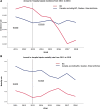The Return on Investment of a Province-Wide Quality Improvement Initiative for Reducing In-Hospital Sepsis Rates and Mortality in British Columbia, Canada
- PMID: 34593705
- PMCID: PMC8923363
- DOI: 10.1097/CCM.0000000000005353
The Return on Investment of a Province-Wide Quality Improvement Initiative for Reducing In-Hospital Sepsis Rates and Mortality in British Columbia, Canada
Abstract
Objectives: Sepsis is a life-threatening medical emergency. There is a paucity of information on whether quality improvement approaches reduce the in-hospital sepsis caseload or save lives and decrease the healthcare system and society's cost at the provincial/national levels. This study aimed to assess the outcomes and economic impact of a province-wide quality improvement initiative in Canada.
Design: Retrospective population-based study with interrupted time series and return on investment analyses.
Setting: The sepsis cases and deaths averted over time for British Columbia were calculated and compared with the rest of Canada (excluding Quebec and three territories).
Patients: Aggregate data were obtained from the Canadian Institute for Health Information on risk-adjusted in-hospital sepsis rates and sepsis mortality in acute care sites across Canada.
Interventions: In 2012, the British Columbia Sepsis Network was formed to reduce sepsis occurrence and mortality through education, knowledge translation, and quality improvement.
Measurements and main results: A return on investment analysis compared the financial investment for the British Columbia Sepsis Network with the savings from averted sepsis occurrence and mortality. An estimated 981 sepsis cases and 172 deaths were averted in the post-British Columbia Sepsis Network period (2014-2018). The total cost, including the development and implementation of British Columbia Sepsis Network, was $449,962. Net savings due to cases averted after program costs were considered were $50.6 million in 2018. This translates into a return of $112.5 for every dollar invested.
Conclusions: British Columbia Sepsis Network appears to have averted a greater number of sepsis cases and deaths in British Columbia than the national average and yielded a positive return on investment. Our findings strengthen the policy argument for targeted quality improvement initiatives for sepsis care and provide a model of care for other provinces in Canada and elsewhere globally.
Copyright © 2022 The Author(s). Published by Wolters Kluwer Health, Inc. on behalf of the Society of Critical Care Medicine and Wolters Kluwer Health, Inc.
Conflict of interest statement
Dr. Khowaja received support for article research from the Michael Smith Foundation for Health Research (18164). Ms. Krause received funding from the University of British Columbia. Mr. Ridout and Ms. Kennedy disclosed they are employees of the British Columbia Patient Safety & Quality Council. Mr. Young disclosed government work. The remaining authors have disclosed that they do not have any potential conflicts of interest.
Figures


References
-
- Angus DC, van der Poll T: Severe sepsis and septic shock. N Engl J Med 2013; 369:2063 - PubMed
MeSH terms
LinkOut - more resources
Full Text Sources
Medical

